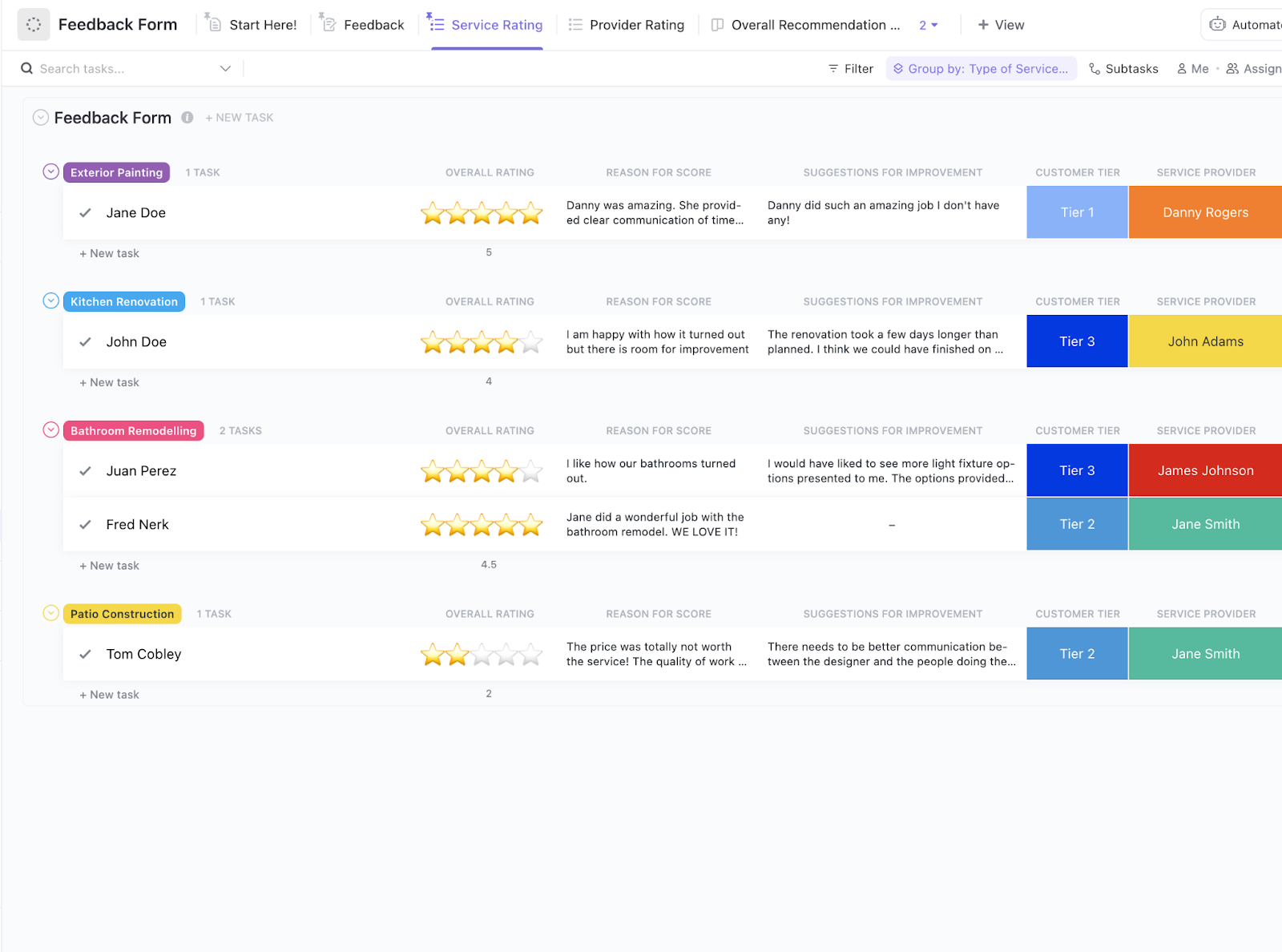الحصول على التغذية الراجعة من أفضل الطرق لتحسين أداء الموظفين وفريق العمل. ⭐️
هناك الكثير من الطرق لتوليد الرؤى، ولكن بعض الاستراتيجيات أكثر شمولاً من غيرها. إذا كنت تريد نظام مراجعة يحفز نمو الموظفين وتطورهم، ففكر في نهج التغذية الراجعة بزاوية 360 درجة. 🔄
تم تصميم طريقة المراجعة هذه لتسليط الضوء على مجالات القوة وتحديد المجالات التي يمكن للموظفين تحسينها. إنها عملية مستمرة، مما يجعل الموظفين ينمون ويطورون مهاراتهم في جميع الأوقات.
في هذا المنشور، سنشرح لك ما هي التغذية الراجعة بزاوية 360 درجة ونوضح لك كيفية تطبيق النظام في ست خطوات بسيطة. سنقوم بمشاركة أمثلة للتغذية الراجعة ونسلط الضوء على إيجابيات وسلبيات طريقة التغذية الراجعة هذه لمساعدتك في تنفيذ أفضل استراتيجية للتغذية الراجعة لعملك. ✨
ما هي التغذية الراجعة 360 درجة؟
عادةً ما يتم تقديم التغذية الراجعة القياسية من قبل المديرين إلى التقارير المباشرة. لكن التغذية الراجعة بزاوية 360 درجة - والمعروفة أيضًا باسم التغذية الراجعة متعددة التقييمات - مختلفة بعض الشيء. فكر فيها كطريقة لمساعدة موظفيك على التطور، بدلاً من مجرد تقييم مقاييس أدائهم. 💪
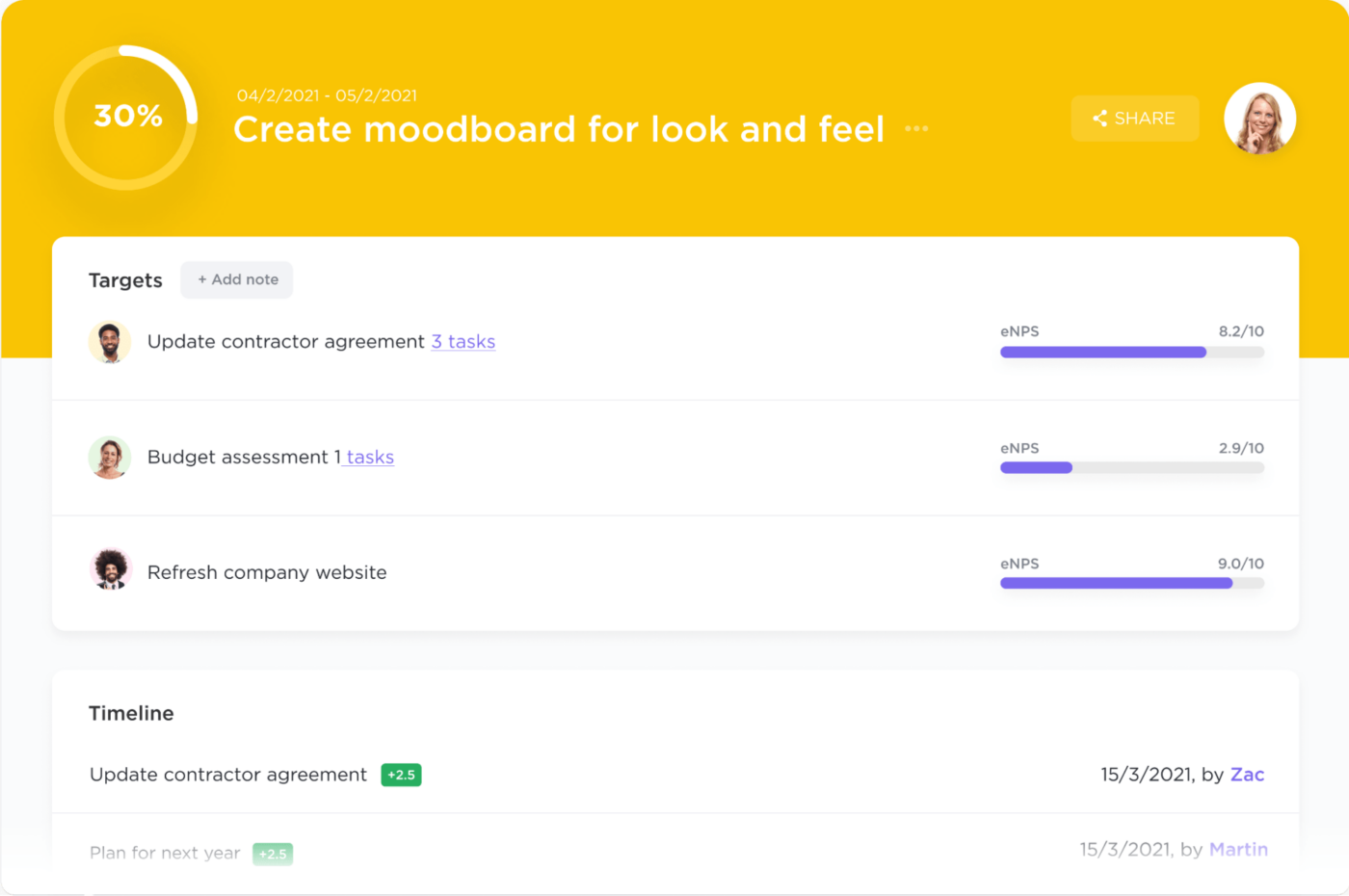
أنشئ أهدافًا ذكية في ClickUp بطرق متعددة لتتبع التقدم المحرز وتحقيق أهدافك
مع هذا إدارة الأداء استراتيجية إدارة الأداء، سيظل الموظفون يتلقون مراجعات من المديرين والمشرفين - بالإضافة إلى عدد قليل من أعضاء الفريق الآخرين الذين قد لا يشرفون على عملهم بشكل مباشر.
وغالباً ما يكون هؤلاء المراجعون الإضافيون زملاء عمل في نفس القسم أو زملاء متعددي الوظائف يعملون بشكل وثيق مع فريقك. تستخدم العملية ملاحظات مجهولة المصدر لتحديد الكفاءات ومجالات التحسين. تتضمن معظم البرامج أيضًا عنصر التقييم الذاتي.
الهدف الرئيسي من هذه الطريقة هو توليد الأفكار والملاحظات البناءة من مجموعة متنوعة من الأفراد لتحسين أداء الموظفين. ومن خلال هذه العملية، يمكنك في نهاية المطاف تحديد المشكلات المحتملة في عملياتك الحالية مع تعميق الصداقة الحميمة لفريقك.
كيف تجمع التغذية الراجعة بزاوية 360 درجة؟
من خلال مراجعات الأداء القياسية، يتلقى الموظفون ملاحظات حول مدى جودة أدائهم من حيث تلبية مقاييس معينة. أما مع التغذية الراجعة بزاوية 360 درجة، فالهدف هو تقديم رؤى مع التركيز على تطوير الموظفين بدلاً من ذلك.
هناك العديد من الطرق لجمع التغذية الراجعة بزاوية 360 درجة، مما يعني أنه لا توجد خطة واحدة محددة يجب اتباعها. بشكل عام، يجب أن تكون العملية واضحة وشفافة وداعمة من البداية إلى النهاية. إليك إطار عمل للتغذية الراجعة 360 درجة خطوة بخطوة يمكنك تخصيصه ليناسب احتياجات عملك. 🌻
1. تحديد الأهداف
ابدأ العملية بشرح نهج التقييم بزاوية 360 درجة لأعضاء فريقك. تذكر أنه يجب أن يكون تقييمًا للتطوير وليس تقييمًا للأداء. دع الجميع يعلمون أنه سيتم تقييمهم بناءً على تطورهم المهني.
هذا يساعد على تجنب المنافسة بين الموظفين، وهو أمر شائع أثناء مراجعات الأداء لأن العديد من أعضاء الفريق يتنافسون على نفس المكافآت. كما أنه يضمن أيضًا أن تكون الملاحظات عضوية ولا يتم التلاعب بها.
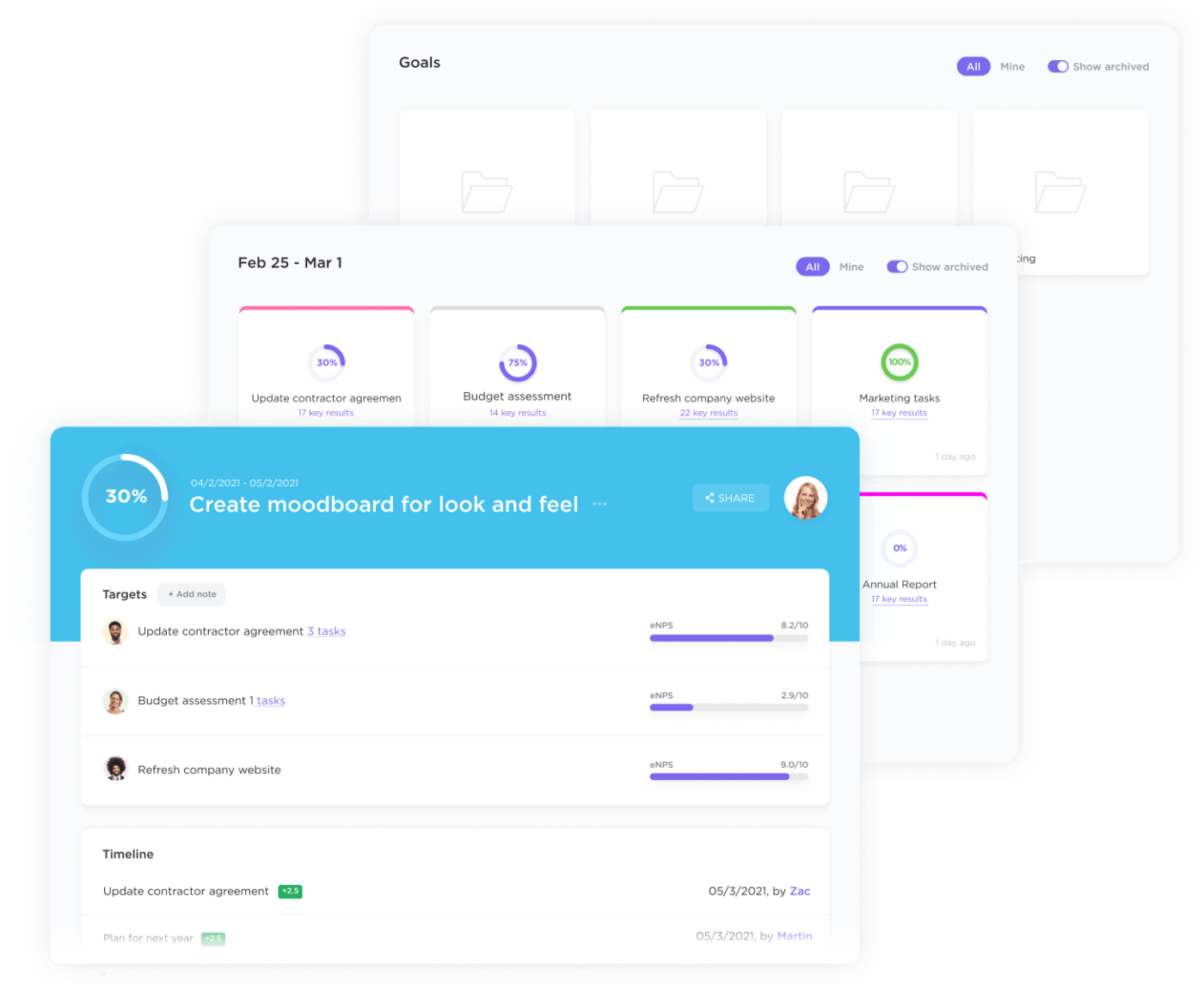
استخدم ميزة تتبع الأهداف في ClickUp للبقاء على المسار الصحيح لتحقيق أهدافك من خلال جداول زمنية واضحة وأهداف قابلة للقياس وتتبع التقدم المحرز تلقائيًا
استخدم أهداف ClickUp ميزة تحديد أهداف تقييم الملاحظات بزاوية 360 درجة. قم بتقسيم الهدف العام إلى أهداف قابلة للقياس - مثل إكمال استبيان الملاحظات، وتقديم الردود، و جدولة اجتماعات 1 على 1 .
2. استضافة دورة تدريبية للمقيّمين
نظرًا لأن التقييم بزاوية 360 درجة سيكون جديدًا على العديد من موظفيك، قم بجدولة جلسة تدريبية لجميع أصحاب المصلحة الذين سيشاركون في تقييم أعضاء فريقك. إذا كان لديك شركة صغيرة، يمكنك حتى إجراء التدريب عبر الإنترنت.
أثناء التدريب، تأكد من مناقشة عملية التقييم، بما في ذلك أي معايير تقييم. ضع جداول زمنية لعملية التقييم، وحدد نقطة اتصال للأسئلة الإجرائية.
3. إنشاء استبيان
بمجرد الانتهاء من وضع الأساس، حان الوقت للبدء فعليًا في جمع الملاحظات. من الطرق السهلة للقيام بذلك استخدام قالب نموذج الملاحظات من ClickUp . ابدأ بإنشاء نموذج وإضافة حقول للأسئلة المختلفة. 📝
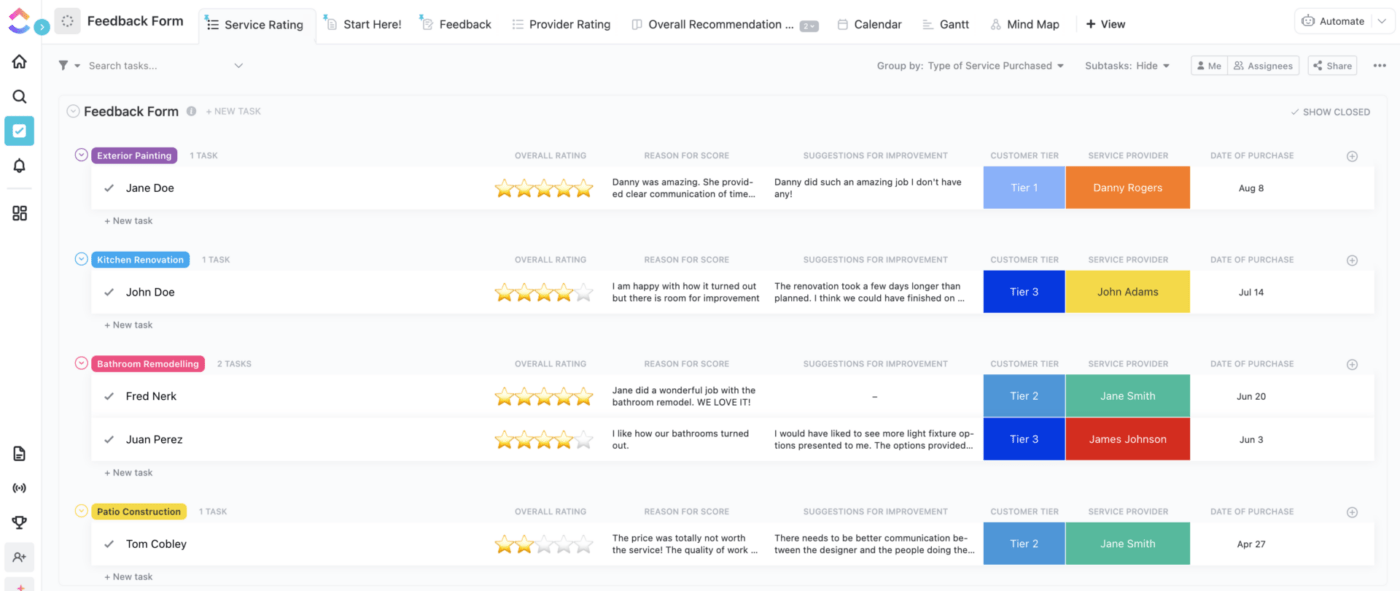
قم بتخصيص قالب نموذج ملاحظات ClickUp مع الأسئلة التي تريد أن يجيب عليها كل مقيِّم
بالنسبة لكل سؤال من أسئلة التغذية الراجعة بزاوية 360 درجة، حدد ما إذا كنت تريد أن تكون الإجابات مفتوحة أو على مقياس تقييم. تجعل المقاييس عملية التقييم أسرع ويمكن أن توفر رؤى رقمية حول متوسط مستوى العمل المنجز على مدار الوقت، بدلاً من موقف واحد محدد.
بشكل عام، يجب أن تركز أسئلة استبيان التغذية الراجعة 360 درجة على ثمانية إلى 10 كفاءات. حدد الاستبيان بـ 40 سؤالاً أو أقل، خاصة إذا كنت تستخدم أسئلة مفتوحة. يمكن للنماذج الطويلة جدًا أو التي تستغرق وقتًا طويلاً جدًا أن تخلق عبئًا على عبء عمل الآخرين، وقد يقدم بعض المستجيبين ملاحظات أقل تفصيلاً بسبب الإرهاق.
باستخدام قالب نموذج ClickUp، يمكنك إنشاء مهام جديدة تلقائيًا بمجرد اكتمال الاستبيان. يمكن أن تتضمن هذه المهام جدولة اجتماع فوري لمراجعة النتائج و عناصر العمل بناءً على الإجابات على أسئلة معينة داخل النموذج.
4. تحليل الملاحظات
بمجرد إكمال جميع أعضاء الفريق للتقييم الذاتي وقيام جميع المراجعين بتقييم أعضاء فريقهم، فقد حان الوقت لتحليل النتائج ومشاركتها. تتمثل إحدى طرق القيام بذلك في قالب ابدأ وتوقف وتابع . مصممة للقضاء على التحيز والديناميكيات الاجتماعية في عملية التغذية الراجعة، وهي مصممة للقضاء على التحيز والديناميكيات الاجتماعية في عملية التغذية الراجعة، وتضع رؤى واضحة من عملية التغذية الراجعة 360 درجة.
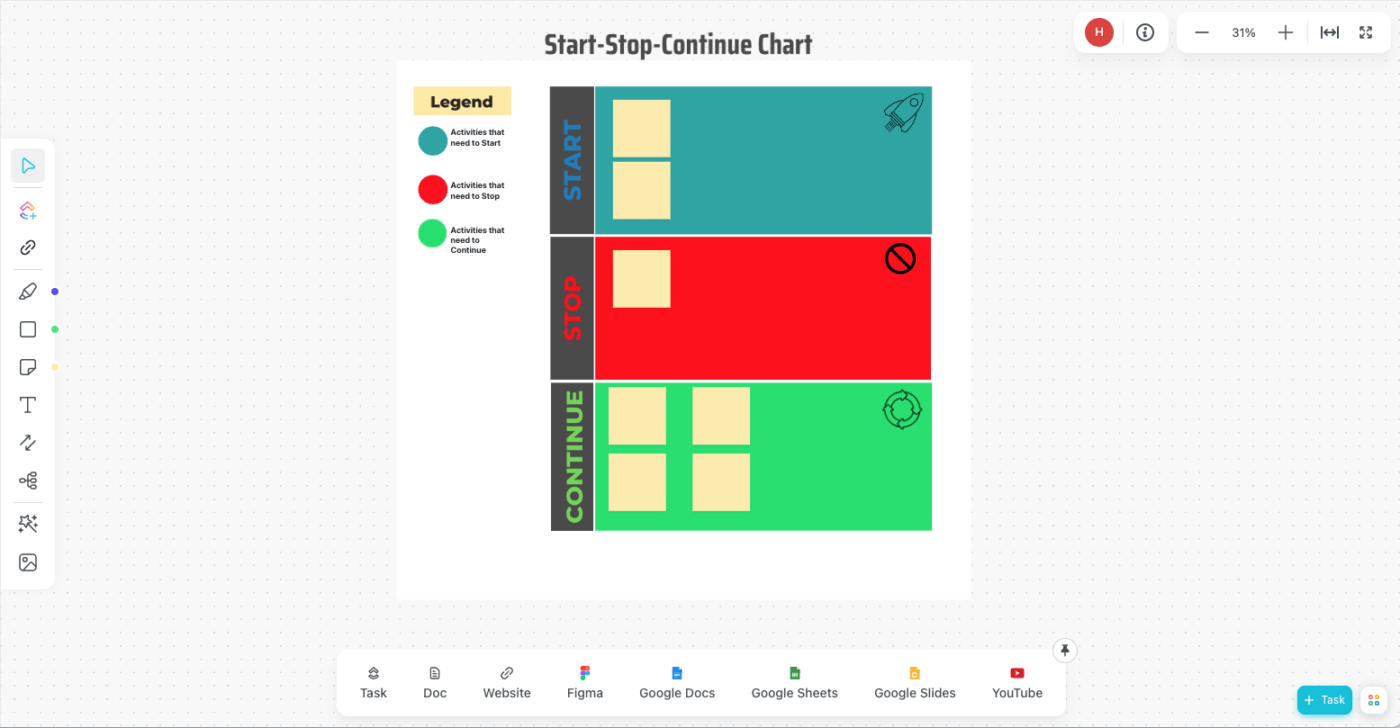
حسِّن النتائج باستخدام مخطط البدء-التوقف-المتابعة وفكِّر في الأنشطة التي يجب أن تبدأ أو تنتهي أو تستمر للحصول على أفضل النتائج
A ابدأ إيقاف المتابعة يتيح لك القالب إنشاء مناقشة مع ثلاثة أقسام متميزة:
- ابدأ: تسليط الضوء على السلوكيات والإجراءات التي يجب على الموظف البدء في تنفيذها على الفور
- التوقف: تحديد الأشياء التي يجب على الموظف التوقف عن تنفيذها. قد تشمل هذه الإجراءات التي تهدر الموارد أو تخلق عقبات أمام الموظفين الآخرين. ويمكن أن تشمل أيضًاعادات العمل التي تمنع الموظف من مواصلة تطوير مهاراته
- استمر: الاعتراف بمكاسب الموظف وما يقوم به بشكل جيد بالفعل. التركيز على المجالات التي ينجحون فيها حاليًا ومدى أهمية استمرارهم في هذه الأعمال
5. وضع خطة تواصل
بمجرد حصولك على تعليقات الأقران على عمل الموظف، شارك النتائج ليس فقط مع الموظف ولكن أيضًا مع الفريق ككل. وهذا لا يعني استدعاء الأفراد أمام أقرانهم. بدلاً من ذلك، تكمن الفكرة في إنشاء خطة تواصل وتحديد مجالات التحسين المشتركة ككل. 👨🏽💻
انتقل إلى قوالب خطة التواصل للعثور على الطريقة التي تناسب عملك. من عناصر العمل إلى خطط الاستراتيجية، هناك قالب لضمان شفافية العملية الخاصة بك وغنية بالمعلومات.
قرّر ما إذا كانت اتصالاتك ستقتصر على التواصل الفردي البسيط أو إنشاء جداول تواصل أكثر تفصيلاً للتحقق من الموظفين بانتظام. نظرًا لأن هذه هي التغذية الراجعة بزاوية 360 درجة، فإن عمليات التحقق لا تقتصر على المديرين والتقارير المباشرة. قم بإعداد خطط تواصل لأعضاء الفريق والمُقيِّمين للحفاظ على استمرار محادثة التطوير.
6. تخصيص النموذج
أنت تفهم عملك أفضل من أي شخص آخر، لذا خذ بعض الوقت للتفكير في احتياجات شركتك وكيف يمكنك استخدام الملاحظات لتحفيز تطوير الموظفين.

اطلع على أكثر من 15 طريقة عرض في ClickUp لتخصيص سير عملك وفقًا لاحتياجاتك
ClickUp مليء بالمئات من الميزات القابلة للتخصيص لمعالجة هذه المهمة بالضبط. يمكنك إنشاء حقول مخصصة، وجمع استبيانات الموظفين، والوصول إلى أكثر من 15 طريقة عرض مرنة لتحليل نتائجك. إذا كان برنامج ملاحظات الموظفين الخاص بك معقدًا، فاعمل مع الاستشاريين لبناء خطة عمل وعملية مخصصة.
أمثلة على 360-التغذية الراجعة
عندما يتعلق الأمر بنظام التقييم بـ 360 درجة، ستختلف الإجابات اعتمادًا على منظور المقيّم وعلاقته بالموظف. وهذا يعني أن بعض المراجعات بـ 360 درجة قد تحتوي على عنصر الأداء بينما سيكون البعض الآخر أكثر استنادًا إلى العملية أو يركز على المهارات. 🙌
على سبيل المثال، لنفترض أنك مشرف تسويق تقدم ملاحظاتك لمدير تحسين محركات البحث. قد تركز ملاحظاتك الشاملة على مدى استيفائهم لمقاييس الترتيب وكيفية تكيفهم مع تحديثات Google الأساسية. بالإضافة إلى ذلك، قد تقدم ملاحظات حول أسلوب إدارتهم وتسلط الضوء على مهاراتهم في التواصل.
مثال آخر هو نظام تقييم 360 درجة حيث يقوم أحد أعضاء فريق تطوير الويب بتقييم مدير المشروع. نظرًا لأن هذين الشخصين ليسا في نفس الفريق المباشر، فقد لا تكون هناك مناقشة لأداء الأهداف. بدلاً من ذلك، قد تركز الملاحظات على علاقة العمل أو المجالات التي يمكن لمدير المشروع أن يتعلم فيها مهارات إضافية متعلقة بالتطوير.
إيجابيات وسلبيات التغذية الراجعة بزاوية 360 درجة
كما هو الحال مع جميع عمليات المراجعة، هناك مزايا وعيوب لنهج التغذية الراجعة 360 درجة. استخدم الجدول أدناه للحصول على نظرة عامة سريعة على إيجابيات وسلبيات نظام قياس الأداء هذا. ولإلقاء نظرة أكثر تعمقًا، تابع القراءة للعثور على تحليل لطريقة التغذية الراجعة بزاوية 360 درجة - الجيد منها والسيئ. 👀
| الإيجابيات | السلبيات |
|---|---|
| تزيد من الوعي الذاتي بنقاط القوة والضعف | تصبح غير منظمة إذا تم تنفيذها بسرعة كبيرة أو بدون نهج واضح |
| يبني تواصلاً مفتوحًا | يجب أن يكون جزءًا من تحليل أكبر للأداء وليس عملية مراجعة مستقلة |
| يسلط الضوء على مجالات تدريب الموظفين والتطوير الوظيفي | يجعل من الصعب الحصول على إجابات لأسئلة المتابعة نظرًا لأن الملاحظات مجهولة المصدر |
| يدعم المساءلة ويشجع على أخذ زمام المبادرة كعضو في الفريق | يميل إلى الميل نحو نقاط الضعف بدلاً من تسليط الضوء على نقاط القوة |
| يقلل من التحيز واحتمالية التمييز | يؤدي إلى ملاحظات غير دقيقة أو غير مكتملة نظرًا لعدم امتلاك جميع أعضاء الفريق الخبرة في تقديم الملاحظات |
| ينشئ خريطة طريق للتوقعات عبر الفرق | يزيد من أعباء العمل، مما يعني أن بعض أعضاء الفريق قد يجدون عملية المراجعة مملة |
إيجابيات التغذية الراجعة بزاوية 360 درجة
هناك العديد من الفوائد لطريقة التغذية الراجعة بزاوية 360 درجة. من فتح خطوط الاتصال إلى تسليط الضوء على مجالات التحسين، إليك الأسباب التي تجعلك تدمج نظام المراجعة هذا في عملياتك.
يزيد من الوعي الذاتي
من خلال الملاحظات التفصيلية ومكون التقييم الذاتي، يصبح الموظفون أكثر وعياً بالذات. تعمل الرؤى بمثابة أداة للتطوير لتسليط الضوء على المجالات التي يمكن للموظف أن يتحسن فيها وما يقوم به بالفعل بشكل جيد.
على عكس مراجعات الأداء، يمكن للموظف استخدام هذه الأداة الصريحة للتغذية الراجعة لتحسين أشياء مثل الانضباط الذاتي وعادات العمل اليومية، ومهارات التواصل بين الأقسام.
إنشاء خطوط اتصال مفتوحة
استخدام التغذية الراجعة من وجهات نظر مختلفة يدعم بشكل عام إدارة الفريق ويعزز التواصل بشكل أفضل. يمكن للأقران التواصل مباشرة مع بعضهم البعض لتقديم الملاحظات، بدلاً من إبقاء التواصل بين المديرين والتقارير المباشرة. 🗣️

باستخدام ClickUp، يمكن لفريقك التواصل بفعالية وكفاءة طوال يوم العمل
ينتقل التركيز من التقييمات المستندة إلى الأداء إلى خلق ثقافة عمل حيث يمكن للأقران مشاركة طرق التحسين مع بعضهم البعض. يمكنهم أيضًا تقديم الدعم إذا كانت لديهم خبرة في مجال يحتاج فيه أحد الأقران إلى التحسين.
يؤكد على مجالات التدريب
عندما يتعلق الأمر بتطوير الموظفين، لا يكفي مجرد تحديد مجالات التحسين. فأنت تريد أن تخلق ثقافة يكون فيها التدريب مهمة يومية ويكون الموظفون على دراية دائمة بالنمو والتعلم.
قد يحتاج بعض الموظفين إلى العمل على مهاراتهم القيادية أو مهارات التواصل، بينما قد يحتاج آخرون إلى المساعدة في حل المشكلات. من تطوير المهارات القيادية ومهارات التعامل مع الآخرين إلى المهارات التقنية، تضع التغذية الراجعة 360 درجة الأساس لتدريب الموظفين وزيادة فعاليتهم.
يشجع على المساءلة
من خلال إنشاء نظام تغذية راجعة منتظم ومستمر، يمكن للمدراء والموظفين وضع خطط تطوير لتحسين المساءلة. ستجد زيادة مشاركة الموظفين نظرًا لأن كل شخص يحتاج إلى العمل بشكل أوثق مع أقرانه.
يقلل من التحيز
نظرًا لأن التغذية الراجعة بزاوية 360 درجة تأتي من مجموعة متنوعة من وجهات النظر والمصادر، فإن فرصة التمييز والتحيز تقل بشكل كبير. وهذا واضح بشكل خاص بالنسبة للتحيزات المعرفية مثل تأثير الهالة والقرن حيث يمكن أن تنحرف ردود الفعل بناءً على التفاعلات الأخيرة والأداء السابق.
يضع خارطة طريق للتطوير
من خلال تسليط الضوء على مجالات مختلفة للتحسين من خلال التغذية الراجعة بزاوية 360 درجة، فإنك تضع الأساس لخارطة طريق لتطوير الموظف بشكل أفضل. فبدلاً من تصنيف ما إذا كان الموظف قد حقق مقياسًا ما أم لا، فإنك ستغوص في المهارات التي يستخدمها الموظف للوصول إلى ذلك. عندما تجد مجالات للتحسين، يمكنك إعداد برامج ومبادرات تدريبية لتلبية تلك الاحتياجات في جميع أنحاء الشركة. 🗺️
سلبيات التغذية الراجعة 360 درجة
قليل جدًا من الأشياء في العالم تتسم بالكمال، وعملية التغذية الراجعة 360 درجة لا تختلف عن ذلك. في حين أنها بشكل عام أداة رائعة للعديد من الشركات، إلا أن هناك بعض العيوب.
يمكن تجنب العديد من هذه السلبيات من خلال تنفيذ التغذية الراجعة بشكل مدروس. فيما يلي بعض السلبيات التي يجب الانتباه إليها عند استخدام أسلوب التغذية الراجعة بزاوية 360 درجة.
يمكن أن تشعر بعدم التنظيم
عند تطبيقه بسرعة كبيرة أو بدون أهداف واضحة، يمكن أن يبدو هذا النهج في التغذية الراجعة غير منظم. وبما أن هناك أيضًا العديد من الأجزاء المتحركة والكثير من الموظفين المعنيين، يمكن أن تسقط الأمور من خلال الشقوق. ربما تنسى تقديم التغذية الراجعة لأحد الزملاء أو ربما يتم تخطي خطوة التقييم.
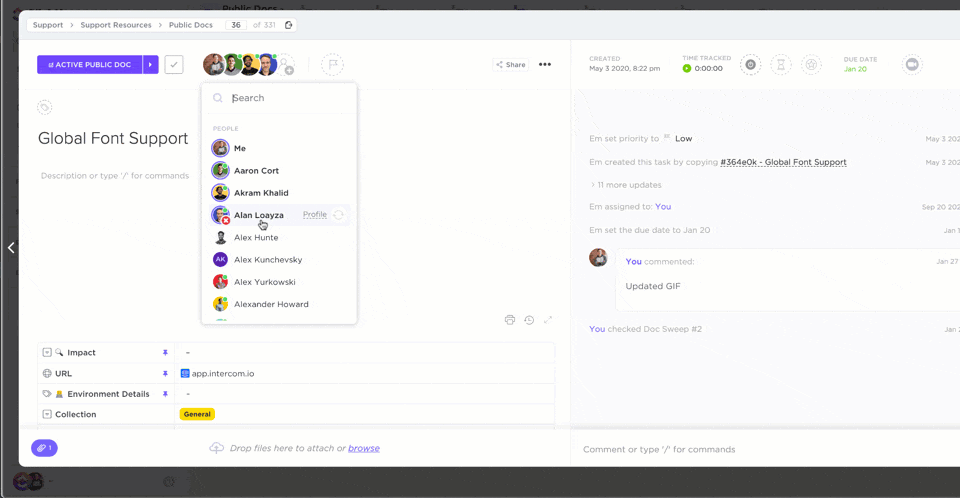
تعيين المهام لشخص واحد أو عدة أشخاص لضمان بقائها على رادارات أعضاء الفريق المناسبين
لتجنب ذلك، استخدم أداة إدارة المشروع مثل ClickUp للبقاء منظمًا. قم بتعيين المهام لأعضاء الفريق المعنيين، وقم بإجراء مراجعات للعمليات للتأكد من عدم تفويت أي شيء.
إنه ليس حلاً متكاملاً
تم تصميم الملاحظات بزاوية 360 درجة لتعمل كجزء من نظام تقييم أكبر للموظفين. إنها مثالية لتوليد النقد البناء حول المهارات والقدرات، ولكنها ليست جيدة في تقييم الأداء. استخدمه كعنصر واحد فقط في نظام المراجعة الخاص بك للحصول على أفضل النتائج.
التغذية الراجعة مجهولة المصدر
في حين أن عدم الكشف عن الهوية يعني أن الناس يشعرون بالحرية في أن يكونوا صادقين بوحشية، إلا أنه يعني أيضًا أن المتابعة أكثر صعوبة. إذا تلقى أحد الموظفين ملاحظات لا يفهمها تمامًا، فمن الصعب الحصول على توضيح لأنه غير متأكد من الذي قدمها. 🥸
للتغلب على هذه المشكلة، فكر في توظيف أو تدريب شخص ما ليكون مدربًا لعملية 360 درجة. حيث يمكن أن يكون بمثابة وسيط لتوضيح الملاحظات ومساعدة الموظفين على تعلم كيفية فهم مراجعاتهم.
التركيز على نقاط الضعف
عند القيام بعملية التقييم بزاوية 360 درجة بشكل متسرع، قد تنحرف عملية التقييم بزاوية 360 درجة نحو الملاحظات السلبية وتقييمات أداء الفريق. لتجنب ذلك، يجب التأكيد في مرحلة الأهداف على أن الفكرة هي تحسين الاحتفاظ بالموظفين وتعزيز التطوير.

احرص على أن يكون كل هدف محددًا وقابلًا للقياس وقابلًا للتحقيق وملائمًا ومحددًا زمنيًا
كن واضحًا أن نوع الملاحظات التي تبحث عنها تستند إلى الكفاءات، بدلاً من تلبية المقاييس المستهدفة. اطلب من الموظفين تسليط الضوء على المجالات التي يتم فيها العمل بشكل جيد إلى جانب المجالات التي تحتاج إلى تحسين.
لا يمكن لجميع الموظفين تقديم ملاحظات جيدة
الحقيقة هي أنه ليس لدى الجميع قدرة فطرية على تقديم ملاحظات بناءة. فبعض الناس لا يقدمون ما يكفي من التفاصيل، والبعض الآخر يقدم الكثير.
وفي أحيان أخرى، قد تؤدي علاقات العمل التنافسية إلى تقديم ملاحظات غير دقيقة أو سلبية أكثر من اللازم. قم بإنشاء ضوابط وتوازنات من خلال مراجعة الملاحظات ومعالجة أي مجالات لا يوجد فيها توافق في الآراء.
قد تزيد أعباء العمل
تقديم التغذية الراجعة يستغرق وقتًا طويلاً. قد يشعر بعض الموظفين أن هذه العملية تزيد من عبء العمل أكثر من اللازم.
لتجنب الإرهاق والإعياء من تقديم الملاحظات، اجعل استبياناتك قصيرة وموجزة. اطلب من الموظفين مراجعة عملية تقديم التغذية الراجعة وتنفيذ الاقتراحات أثناء قيامك بذلك. 📚
مراجعات الأداء مقابل التغذية الراجعة بزاوية 360 درجة مراجعات الأداء هي أدوات مصممة لتقييم أداء الموظف مقابل مكافأة مثل المكافأة. ومن ناحية أخرى، تهدف التغذية الراجعة 360 درجة إلى مساعدة الموظف على تطوير مهاراته بشكل أفضل. 🛠️
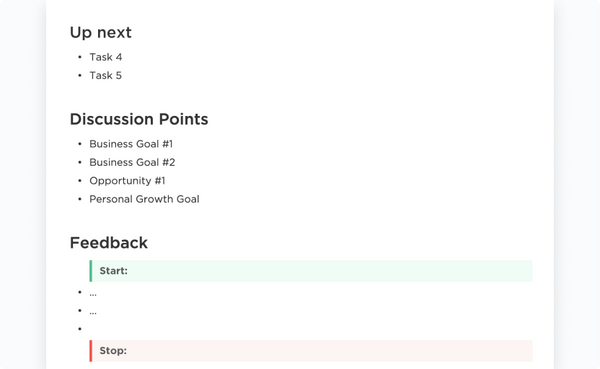
يساعد قالب ClickUp لمراجعة أداء الموظفين فرق العمل على مشاركة الملاحظات والتحسينات القابلة للتنفيذ بشكل أفضل
في حين أن مراجعات الأداء عادةً ما يكون لها نقطة نهاية تتمحور حول هدف ما، فإن الملاحظات التقييمية على نطاق 360 درجة مستمرة. يجب أن تتطور العملية باستمرار، مما يساعد الموظف على تحديد مجالات التحسين. وينبغي أن يتضمن جزء من الإجراء متابعة التواصل حتى تتمكن من مساعدة الموظف على طول الطريق أثناء قيامه بتحسين مهاراته.
ومن الفروق الرئيسية الأخرى بين الاثنين هو أن التغذية الراجعة بزاوية 360 درجة تكون مجهولة الهوية بينما تتم مراجعات الأداء وجهاً لوجه. حيث يتيح عدم الكشف عن الهوية للتقارير المباشرة والمديرين تقديم ملاحظات حقيقية وموثوقة.
قم بإنشاء نظام أفضل للتغذية الراجعة باستخدام ClickUp
يجب ألا تقتصر عمليات المراجعة على المكافآت فقط. يساعد تنفيذ إجراء ناجح للتغذية الراجعة بزاوية 360 درجة على إبقاء التركيز على التطوير. وبهذه الطريقة، يعمل الجميع معًا لتحسين أنفسهم كأفراد وكمساهمين في الفريق ككل. اشترك في ClickUp اليوم وابدأ في إنشاء نظام أفضل للتقييم لموظفيك. سواء كنت ترغب في إنشاء نظام مراجعة لقسم معين أو للشركة بأكملها، يتيح لك ClickUp تخطيط العملية وتعيين المهام مع المواعيد النهائية وتخصيص نموذج لجمع الملاحظات. 🙋🏻♂️
